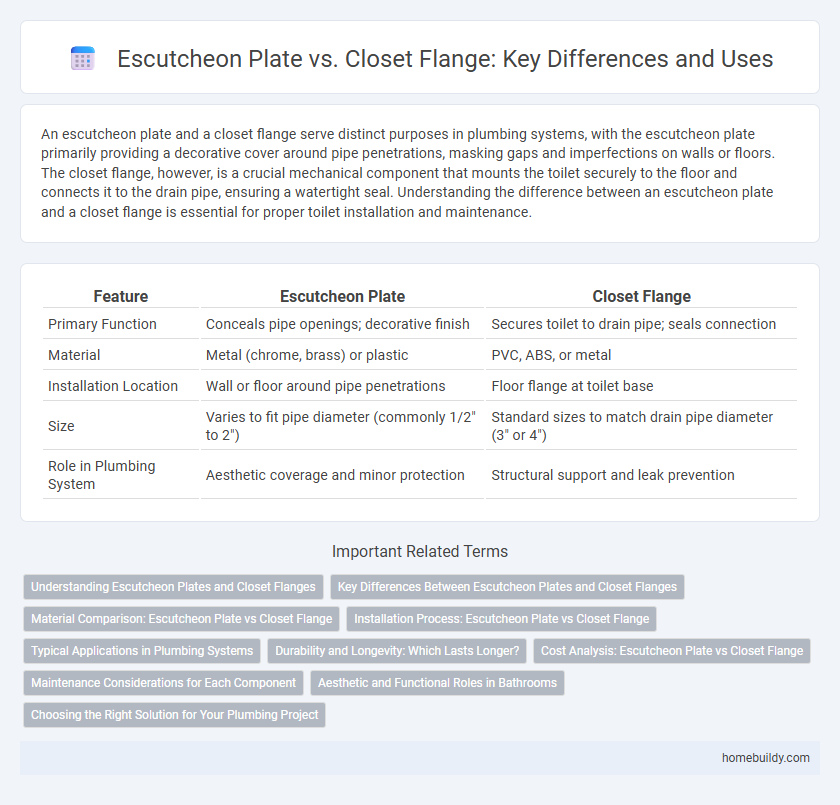An escutcheon plate and a closet flange serve distinct purposes in plumbing systems, with the escutcheon plate primarily providing a decorative cover around pipe penetrations, masking gaps and imperfections on walls or floors. The closet flange, however, is a crucial mechanical component that mounts the toilet securely to the floor and connects it to the drain pipe, ensuring a watertight seal. Understanding the difference between an escutcheon plate and a closet flange is essential for proper toilet installation and maintenance.
Table of Comparison
| Feature | Escutcheon Plate | Closet Flange |
|---|---|---|
| Primary Function | Conceals pipe openings; decorative finish | Secures toilet to drain pipe; seals connection |
| Material | Metal (chrome, brass) or plastic | PVC, ABS, or metal |
| Installation Location | Wall or floor around pipe penetrations | Floor flange at toilet base |
| Size | Varies to fit pipe diameter (commonly 1/2" to 2") | Standard sizes to match drain pipe diameter (3" or 4") |
| Role in Plumbing System | Aesthetic coverage and minor protection | Structural support and leak prevention |
Understanding Escutcheon Plates and Closet Flanges
Escutcheon plates are decorative and protective covers that fit around pipes or fixtures, enhancing aesthetic appeal and preventing drafts or debris from entering gaps. Closet flanges provide a secure mounting point for toilets, connecting the toilet to the drain pipe and ensuring a watertight seal. Understanding the distinct functions of escutcheon plates and closet flanges is crucial for proper bathroom installations and maintenance.
Key Differences Between Escutcheon Plates and Closet Flanges
Escutcheon plates serve as decorative covers that conceal pipe openings and provide a finished look around plumbing fixtures, while closet flanges function as the crucial connection point that secures toilets to the drain pipe and anchor them to the floor. Escutcheon plates are primarily aesthetic, made from materials like stainless steel or plastic, whereas closet flanges are typically constructed from PVC, cast iron, or brass to ensure strength and durability under load. The key difference lies in their roles: escutcheon plates enhance appearance and prevent debris entry, while closet flanges provide structural support and a watertight seal for toilet installation.
Material Comparison: Escutcheon Plate vs Closet Flange
Escutcheon plates are typically made from materials like stainless steel, brass, or plastic, offering corrosion resistance and aesthetic appeal for covering pipe openings. Closet flanges, often constructed from PVC, cast iron, or ABS, provide a durable and sturdy connection between the toilet and the drain pipe. The key difference lies in their material strength and function, with closet flanges designed for structural support while escutcheon plates focus on finishing and sealing.
Installation Process: Escutcheon Plate vs Closet Flange
The installation process for an escutcheon plate involves slipping the plate over the pipe and securing it flush against the wall or floor to conceal gaps and provide a finished look. In contrast, installing a closet flange requires bolting the flange to the floor flange, connecting the toilet's drain to the waste pipe, and ensuring a secure wax ring seal to prevent leaks. While escutcheon plates primarily offer aesthetic coverage and minor protection, closet flanges play a critical structural role in toilet stability and waste pipe alignment.
Typical Applications in Plumbing Systems
Escutcheon plates are primarily used to cover and conceal pipe penetrations in walls, floors, or ceilings, providing a clean and finished appearance around plumbing fixtures such as faucets and showerheads. Closet flanges serve as the critical connection point securing the toilet to the floor and sealing it to the waste pipe, preventing leaks and odors. While escutcheon plates focus on aesthetic pipe coverage and minor protection, closet flanges ensure structural stability and proper waste discharge in plumbing systems.
Durability and Longevity: Which Lasts Longer?
Escutcheon plates are typically made from stainless steel or brass, offering high resistance to corrosion and wear, which enhances their durability in humid environments. Closet flanges are usually constructed from PVC or cast iron, with cast iron flanges providing significant longevity but requiring maintenance to prevent rust. Compared to closet flanges, escutcheon plates have longer-lasting corrosion resistance, but closet flanges, especially cast iron variants, offer greater structural durability essential for securing toilets.
Cost Analysis: Escutcheon Plate vs Closet Flange
Escutcheon plates typically cost between $5 and $15, offering an affordable solution for covering pipe openings and enhancing aesthetic appeal around plumbing fixtures. Closet flanges, priced around $10 to $30, serve a more critical structural role by securing the toilet to the floor and connecting it to the drain pipe. The lower cost of escutcheon plates compared to closet flanges reflects their simpler function, but investing in quality closet flanges is essential for long-term durability and leak prevention.
Maintenance Considerations for Each Component
Escutcheon plates require regular cleaning and inspection to prevent corrosion and maintain their aesthetic appeal, especially in high-moisture environments. Closet flanges demand more intensive maintenance checks for secure sealing and proper fastening to avoid leaks and sewer gas escape. Proper upkeep of both components ensures optimal bathroom fixture functionality and hygiene.
Aesthetic and Functional Roles in Bathrooms
Escutcheon plates enhance bathroom aesthetics by providing a clean, polished finish around pipes and fixtures, concealing rough wall edges and mounting hardware. Closet flanges serve a critical functional role by securely connecting the toilet to the drain pipe and anchoring it to the floor, ensuring stability and preventing leaks. Both components complement each other in bathroom design, balancing visual appeal with essential plumbing functionality.
Choosing the Right Solution for Your Plumbing Project
Escutcheon plates provide a clean and decorative finish around pipe penetrations, while closet flanges secure toilets to the floor and connect them to the drain pipe. Selecting the right component depends on whether the focus is on aesthetic coverage or structural support in your plumbing project. For effective sealing and stability, use closet flanges for toilet installation and escutcheon plates to conceal pipe gaps and enhance visual appeal.
escutcheon plate vs closet flange Infographic

 homebuildy.com
homebuildy.com